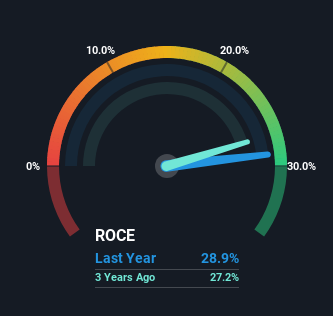Investors Should Be Encouraged By Microsoft's (NASDAQ:MSFT) Returns On Capital
What are the early trends we should look for to identify a stock that could multiply in value over the long term? Ideally, a business will show two trends; firstly a growing return on capital employed (ROCE) and secondly, an increasing amount of capital employed. Put simply, these types of businesses are compounding machines, meaning they are continually reinvesting their earnings at ever-higher rates of return. And in light of that, the trends we're seeing at Microsoft's (NASDAQ:MSFT) look very promising so lets take a look.
Return On Capital Employed (ROCE): What Is It?
For those that aren't sure what ROCE is, it measures the amount of pre-tax profits a company can generate from the capital employed in its business. Analysts use this formula to calculate it for Microsoft:
Return on Capital Employed = Earnings Before Interest and Tax (EBIT) ÷ (Total Assets - Current Liabilities)
0.29 = US$106b ÷ (US$484b - US$119b) (Based on the trailing twelve months to March 2024).
So, Microsoft has an ROCE of 29%. That's a fantastic return and not only that, it outpaces the average of 7.2% earned by companies in a similar industry.
See our latest analysis for Microsoft
In the above chart we have measured Microsoft's prior ROCE against its prior performance, but the future is arguably more important. If you're interested, you can view the analysts predictions in our free analyst report for Microsoft .
So How Is Microsoft's ROCE Trending?
Investors would be pleased with what's happening at Microsoft. The numbers show that in the last five years, the returns generated on capital employed have grown considerably to 29%. The company is effectively making more money per dollar of capital used, and it's worth noting that the amount of capital has increased too, by 75%. The increasing returns on a growing amount of capital is common amongst multi-baggers and that's why we're impressed.
The Bottom Line On Microsoft's ROCE
All in all, it's terrific to see that Microsoft is reaping the rewards from prior investments and is growing its capital base. Since the stock has returned a staggering 236% to shareholders over the last five years, it looks like investors are recognizing these changes. With that being said, we still think the promising fundamentals mean the company deserves some further due diligence.
Like most companies, Microsoft does come with some risks, and we've found 1 warning sign that you should be aware of.
If you'd like to see other companies earning high returns, check out our free list of companies earning high returns with solid balance sheets here.
Have feedback on this article? Concerned about the content? Get in touch with us directly. Alternatively, email editorial-team (at) simplywallst.com.
This article by Simply Wall St is general in nature. We provide commentary based on historical data and analyst forecasts only using an unbiased methodology and our articles are not intended to be financial advice. It does not constitute a recommendation to buy or sell any stock, and does not take account of your objectives, or your financial situation. We aim to bring you long-term focused analysis driven by fundamental data. Note that our analysis may not factor in the latest price-sensitive company announcements or qualitative material. Simply Wall St has no position in any stocks mentioned.

 Yahoo Finance
Yahoo Finance 
